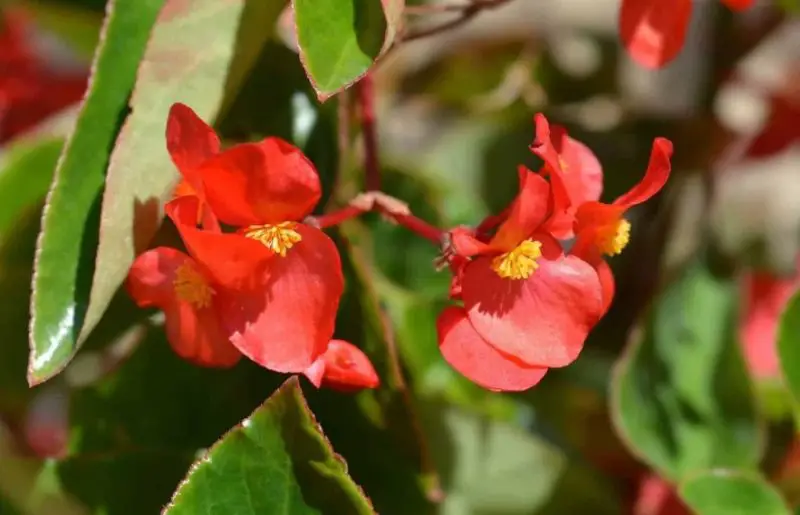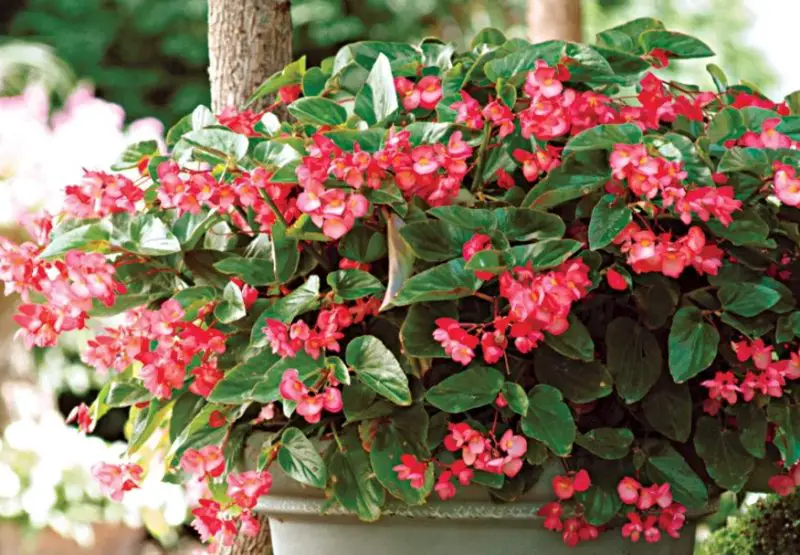Dragon Wing Begonias are a stunning addition to any garden or indoor plant collection. Known for their vibrant, wing-shaped leaves and cascading blooms, these hybrid plants have captured the hearts of both novice and experienced gardeners alike.
Originally developed in the late 1990s, Dragon Wing Begonias combine the best traits of their parent species, offering robust growth, heat tolerance, and a long flowering season.
This guide will explore the essential care techniques and growing tips to help you cultivate thriving Dragon Wing Begonias, whether in containers, hanging baskets, or garden beds.
Dragon Wing Begonia Overview

The Dragon Wing Begonia, also known by several common names, including Begonia ‘Dragon Wing Red,’ Dragon Red Wing Begonia, and Cane Begonia, is a perennial flowering hybrid species belonging to the Begoniaceae family. Scientifically referred to as Begonia x hybrida ‘Dragon Wings,’ this plant was originally cultivated in South America and is highly valued for its lush green foliage and vibrant flowers.
One of the key reasons for the Dragon Wing Begonia’s popularity is its remarkable tolerance for heat and humidity. Despite its similarities, it is often mistaken for the Angel-wing Begonia. This plant is known for its easy growth. It thrives in USDA zones 9–11, growing up to 2 feet tall and blooming all year round.
Dragon Wing Begonia Care and Growing Guide

Dragon Wing Begonias are popular for their vibrant blooms and lush foliage. Here’s a comprehensive care and growing guide for these beautiful plants:
Light
Indoors: Bright, indirect light is best for Dragon Wing Begonias when grown indoors. Direct sunlight can scorch the leaves, causing them to turn brown and crispy. Place the plant in a location where it receives plenty of natural light but is shielded from the harsh rays of the sun, such as near a window with a sheer curtain or under grow lights. Insufficient light can lead to weak growth and fewer blooms, so ensuring the plant gets enough light is crucial for its health and flowering.
Outdoors: Partial shade is ideal for Dragon Wing Begonias when planted outdoors. They can tolerate some morning sun, which is generally milder, but they need protection from the intense afternoon sun that can damage the foliage and flowers. Planting them in a spot that receives dappled sunlight throughout the day or in an area that is shaded during the hottest part of the afternoon will help them thrive. Using shade cloth or planting them under larger plants or trees can also provide the necessary protection from direct sunlight.
Temperature
Dragon Wing Begonias thrive best within an optimal temperature range of 60–75°F (15–24°C). These temperatures mimic their native tropical environment, promoting healthy growth and vibrant blooms. It’s crucial to avoid exposing the plant to temperatures below 50°F (10°C), as this can cause significant stress and potentially damage the plant. Cold temperatures can lead to leaf drop, slowed growth, and, in extreme cases, plant death.
If you’re growing Dragon Wing Begonias outdoors and expect a cold snap, it’s advisable to bring them indoors or provide protective coverings to shield them from the chill. Ensuring a stable, warm environment will help maintain the plant’s overall health and longevity.
Humidity
Dragon Wing Begonias prefer high humidity levels, which mimic their natural tropical habitat. However, they can tolerate the average humidity levels found in most households. To ensure optimal growth and prevent issues such as leaf browning or curling, it’s beneficial to increase the humidity around the plant.
This can be achieved by placing the pot on a pebble tray filled with water, ensuring that the bottom of the pot is above the water level to prevent root rot. Using a humidifier in the room where the plant is located can also help maintain a consistently higher humidity level.
Additionally, misting the plant regularly with water can provide a quick boost in humidity, though it’s essential to avoid over-wetting the leaves to prevent fungal issues.
Soil
Dragon Wing Begonias thrive in a well-draining potting mix that prevents waterlogging and ensures healthy root development. A potting mix designed for African violets works exceptionally well due to its balanced moisture retention and aeration properties.
An ideal composition for this plant includes a blend of peat moss, perlite, and vermiculite. Peat moss retains moisture without becoming waterlogged, providing the necessary hydration for the roots. Perlite improves drainage and aeration, preventing soil compaction and allowing roots to breathe. Vermiculite aids in moisture retention while also contributing to a light and airy soil structure.
This combination ensures that the soil remains consistently moist but never soggy, creating the perfect environment for Dragon Wing Begonias to flourish.
Fertilizing
To keep Dragon Wing Begonias thriving, it is important to feed them regularly during their growing season, which spans from spring to summer. Apply a balanced, water-soluble fertilizer every 4–6 weeks to provide essential nutrients that support robust growth and vibrant blooms.
Opt for a fertilizer with equal ratios of nitrogen, phosphorus, and potassium, such as a 10-10-10 or 14-14-14 formulation. To avoid over-fertilizing, dilute the fertilizer to half strength, which will provide the necessary nutrients without risking damage to the plant.
Over-fertilization can lead to salt buildup in the soil, potentially causing root burns or nutrient imbalances.
Pruning
Pruning Dragon Wing Begonias is essential for maintaining their health and encouraging vigorous new growth. The primary purpose of pruning is to remove dead or yellowing leaves and spent blooms, which can otherwise detract from the plant’s appearance and divert energy away from producing fresh foliage and flowers.
To prune effectively, use clean, sharp scissors or pruning shears to make precise cuts just above a leaf node, which is the small bump or joint on the stem where leaves or branches emerge. This technique not only helps prevent potential diseases and pests from lingering on the plant but also promotes a more compact and aesthetically pleasing shape.
Regular pruning will keep your Dragon Wing Begonia looking its best and support its overall vitality and blooming performance.
Repotting
Repotting Dragon Wing Begonias is necessary every 1-2 years or when the plant has outgrown its current pot. This process helps ensure the plant has enough space for root growth and fresh nutrients.
When repotting, select a new pot that is 1-2 inches larger in diameter than the current one to provide ample room for growth without overwhelming the plant. To transfer the plant, gently remove it from the old pot, taking care not to damage the roots. Loosen any tightly bound roots and place the plant into the new pot filled with fresh, well-draining potting mix. Ensure the plant is centered and at the same depth as it was in the previous pot. Firmly pack the soil around the roots to eliminate air pockets, and water thoroughly to help the plant settle into its new home.
Regular repotting will keep your Dragon Wing Begonia healthy, promote robust growth, and support its ongoing development.
Pests and Problems
Dragon Wing Begonias can be susceptible to a variety of pests and diseases. Common pests include aphids, spider mites, and whiteflies.
Aphids are small, soft-bodied insects that can cause leaf distortion and honeydew buildup, while spider mites are tiny, often invisible pests that create fine webbing and cause stippling on leaves.
Whiteflies, small, white-winged insects, tend to cluster on the undersides of leaves, leading to sticky residue and weakened plant health.
To manage these pests, treat the affected plant with insecticidal soap or neem oil, following the product instructions for application frequency and dosage.
In terms of diseases, powdery mildew and root rot are the most prevalent issues. Powdery mildew presents as a white, powdery coating on leaves and stems, thriving in conditions of high humidity and poor air circulation. To combat powdery mildew, improve air flow around the plant and apply a fungicide if necessary.
Root rot, caused by overwatering and poorly draining soil, manifests as soggy, discolored roots and wilting foliage. To prevent root rot, ensure the soil is well-draining and allow it to dry out slightly between waterings.
Proper watering practices and good air circulation are key to maintaining a healthy Dragon Wing Begonia and avoiding these common problems.
Propagation
Propagation of Dragon Wing Begonias is commonly done through stem cuttings, a straightforward and effective method. To start, select a healthy stem from the plant that is at least 4-6 inches long and has at least one node, which is the small bump on the stem where leaves and roots can emerge. Using clean, sharp scissors or pruning shears, make a clean cut just below the node. Remove the lower leaves from the cutting, leaving a few leaves at the top to help with photosynthesis.
Next, place the prepared cutting in a container with either water or moist potting mix. If using water, ensure that the node is submerged while the leaves remain above the waterline. Change the water every few days to prevent stagnation. If using potting mix, plant the cutting in a small pot filled with a well-draining mixture, such as a blend of peat moss and perlite, and keep the soil consistently moist but not waterlogged.
Place the container in a warm, bright location with indirect light to encourage root growth. Roots should start to develop within a few weeks. Once the roots are a few inches long, or if you are using potting mix, once you see new growth, you can transplant the cutting into a larger pot or its permanent growing location. By following these steps, you can successfully propagate new Dragon Wing Begonias, expand your collection, or share plants with friends and family.
Blooming
Dragon Wing Begonias are known for their vibrant and continuous blooming throughout the growing season, with the most prolific flowering occurring in spring and summer. To maintain and extend the bloom period, it is important to regularly deadhead spent flowers. This involves removing faded or wilted blooms from the plant to prevent them from going to seed and to encourage the development of new flowers.
Use clean, sharp scissors or pruning shears to snip the spent blooms just above the base, where they connect to the stem. This not only helps in directing the plant’s energy towards producing fresh blooms but also keeps the plant looking tidy and vibrant.
Conclusion
In summary, Dragon Wing Begonias are a stunning addition to any garden or indoor space, known for their vibrant blooms and lush foliage. The requirements these plants require to flourish and keep impressing include bright, indirect light, ideal temperatures, high humidity, and well-draining soil.
Regular care, including proper watering, fertilizing, pruning, and repotting, along with vigilant pest and disease management, will keep your Dragon Wing Begonias healthy and flourishing. With attention to these key aspects, you’ll enjoy their beautiful, continuous blooms and vibrant presence throughout the growing season.






